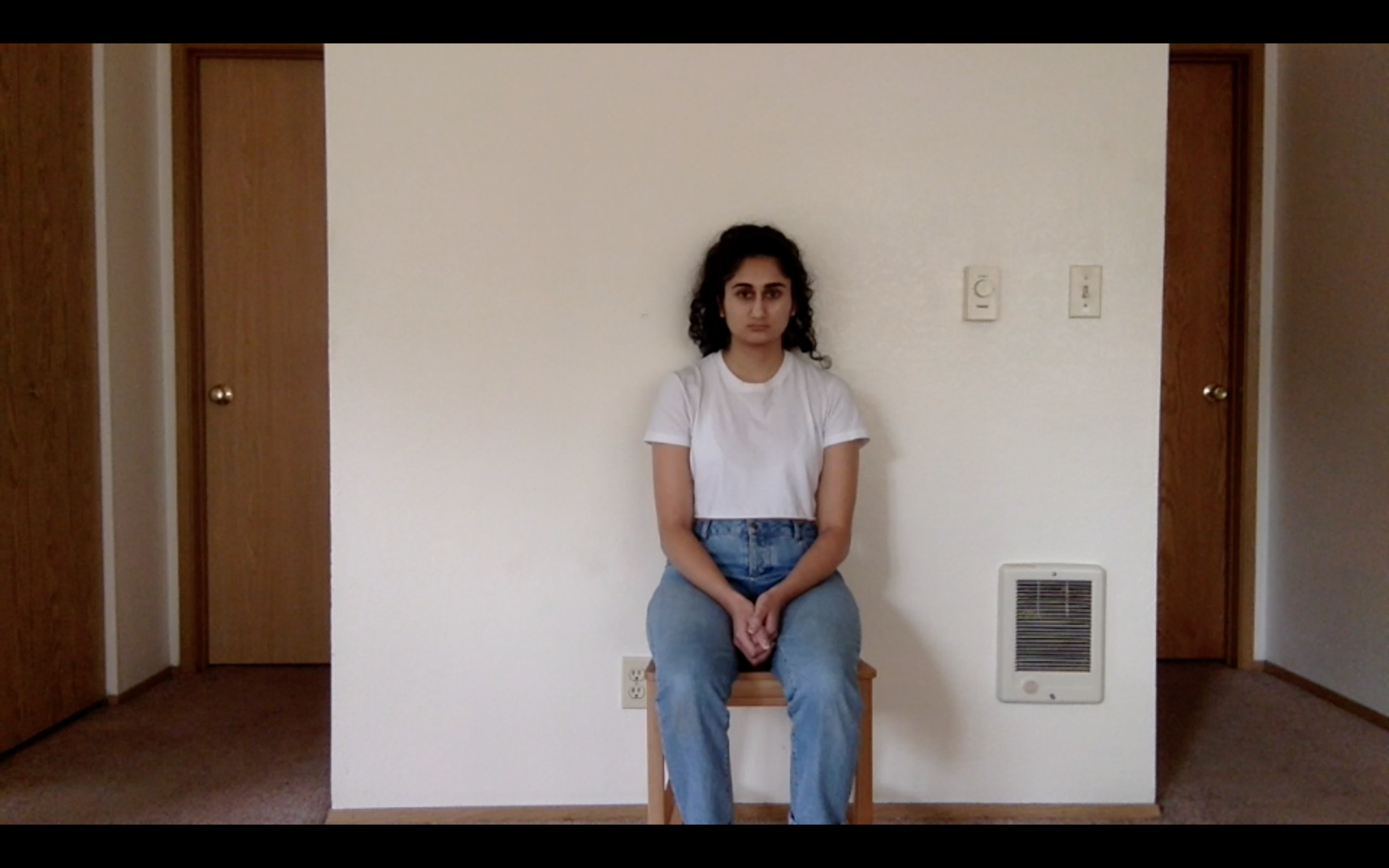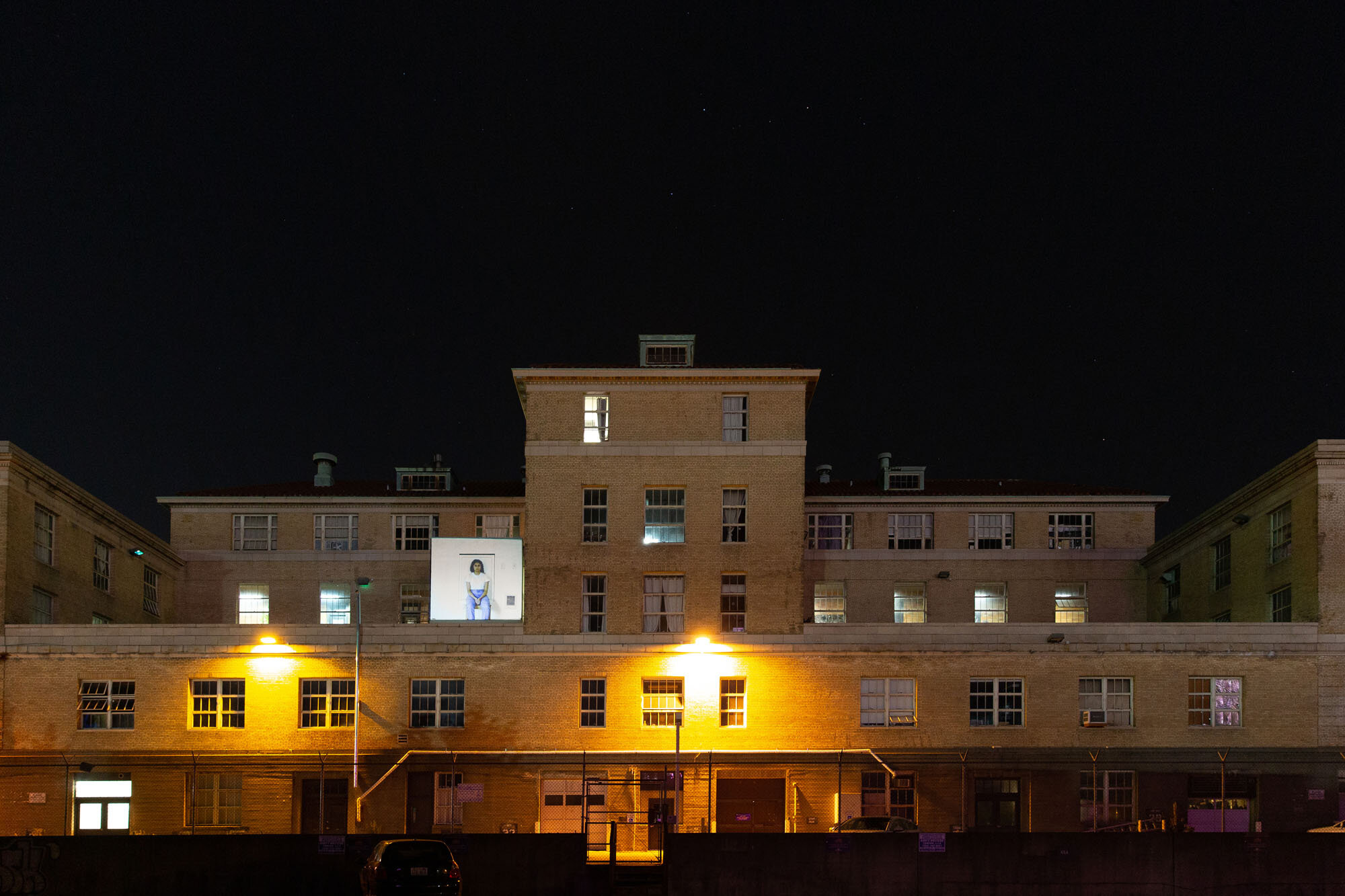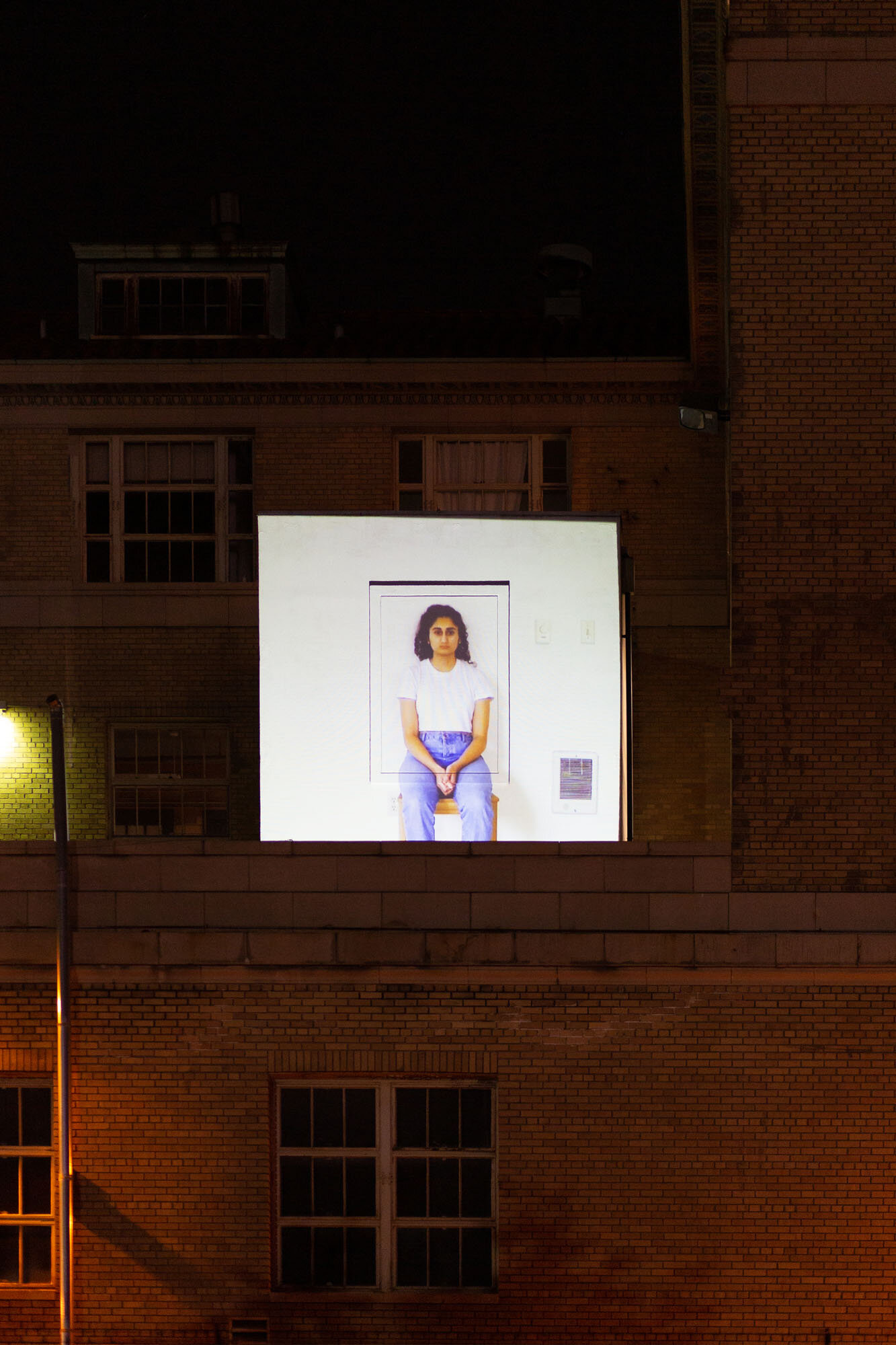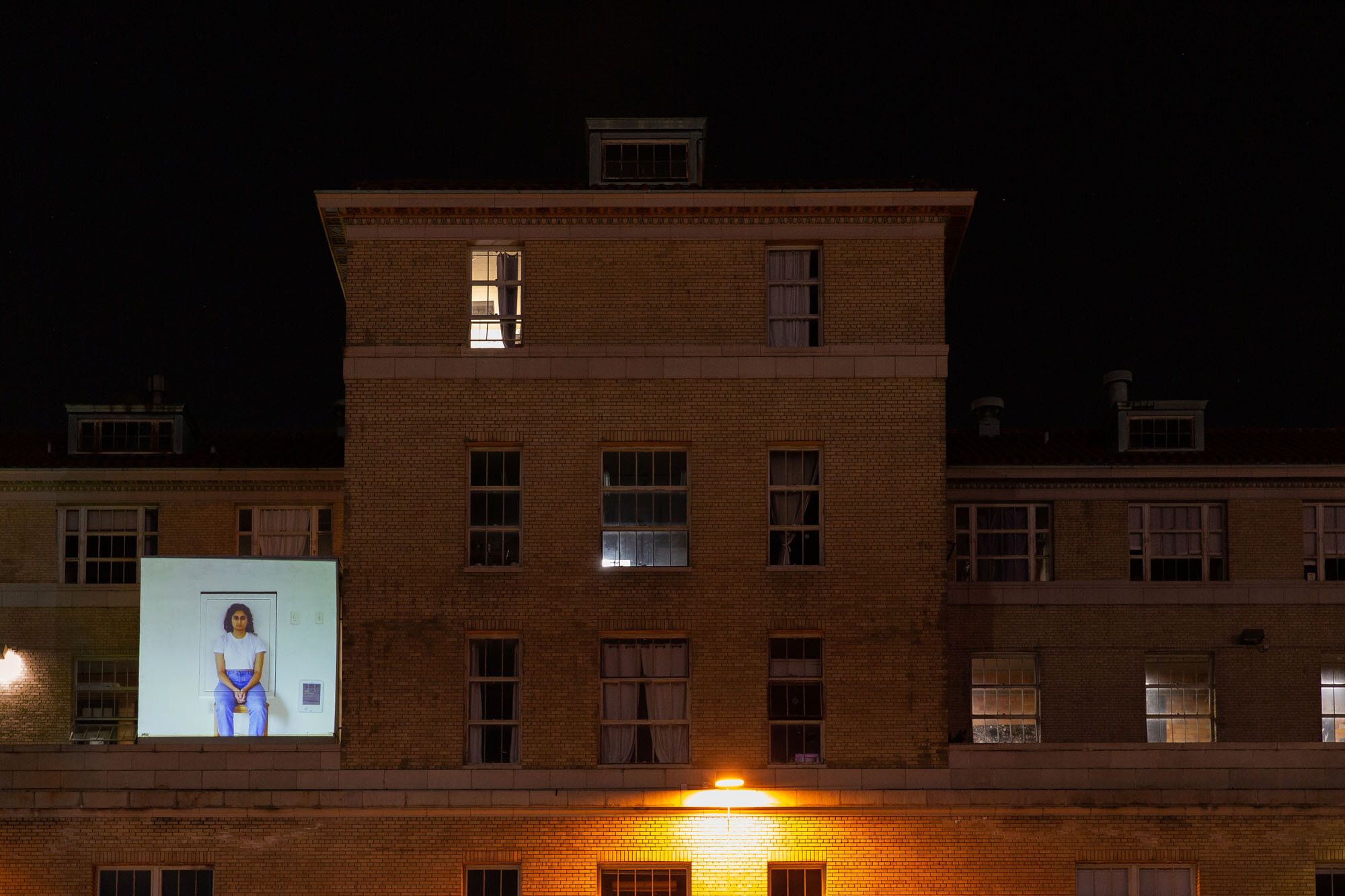Q&A: Nadia Ahmed / The High Wall
By Rafael Soldi | Published October 7, 2020
Interview conducted August
2020Strange Fire Collective is partnering with the High Wall to present interviews with the High Wall’s 2020 featured artists.
The High Wall is an outdoor video projection project at the Inscape Arts Building in Seattle, WA. Honoring the building’s complicated history as an immigration station, the High Wall aims to show the work of artists who are immigrants or working with themes of immigration, borderlands, and diaspora.
Every year the High Wall invites three artists to create an intervention on the building’s facade—a public video projection visible from multiple public spaces. The works were on view August 13-16, 2020. The High Wall is co-curated by Britta Johnson and Rafael Soldi; here we present three conversations between the curators and each artist/artist team:
Alice Gosti
Nadia Ahmed (below)
Gazelle Samizay & Labkhand Olfatmanesh
Nadia Ahmed is a performance artist, sculptor, and arts administrator currently based in Shoreline, WA. She moved from LA to Seattle in 2014, where she earned a BA in Art History and a BA in Three-Dimensional Forum from the University of Washington. She has worked as an educator, programmer, curator, and fundraiser at multiple arts-based organizations. Embracing time as a medium, she uses her artwork to explore the failure and pain of memory as well as her perpetual discomfort, believing that you have to be willing to be uncomfortable and to have harder conversations in order to enact change.
Britta Johnson (BJ): Hi Nadia, Thanks so much for sharing your video with us. Can you describe the transactional context of “50 works in time” and tell us about any initiating events or ideas that led you to make it?
Nadia Ahmed (NA): I made this piece while I was enrolled in school and was bouncing through different part-time jobs and unpaid internships, so production, labor, and value were all things that I was thinking a lot about in my personal life, especially as it relates to often underpaid and underrepresented groups.
“50 works in time” consists of 50 flash drives, each with a label that says only a time and a price. They were originally displayed in the box and packaging that they were shipped in, which was mounted to the wall. On each flash drive is a video of me seated in front of the camera for a set amount of time, very literally giving away my time. It’s important to note that anyone who bought a flash drive while this piece was being shown had no idea what was on it.
To determine the price, the total production cost—flash drives, shipping, label paper, etc.—was added to the minimum wage per hour of the recorded time. This price wouldn’t make a profit, it would just cover the factory cost. While this work was extremely labor and time intensive, being mass-produced within a few days, it does not produce anything as far as the traditional interpretation of ‘production’ goes. I wanted to make something that was not craft or skill-based, but about the act and process of production itself, as well as the labor (physical, emotional, and mental) that goes into it.
The transactional aspect is a key part of the work. The act of buying and selling becomes a performative feature, turning the audience into participants. This feels similar to the transaction between the artist and the viewer in a performance piece. Through this transaction, I explore what it means to buy a piece of art, and what it means to buy an object. “50 works in time” asks how we value labor and time, and questions what changes the value of something.
Rafael Soldi (RS): The transactional context of the work is also interesting because the rules that govern the price of an artwork are very different from the parameters you have set to price your work.. The fact that we can buy an artwork for under $10 says a lot about how we value human labor versus how we value luxury objects.
BJ: I’m struck by how much I notice the slow passage of time while watching it, and how long ten minutes feels. Another thing I note: in the video, though you are more or less motionless, there is no sense that you are at rest; you are clearly doing a job. Can you talk about the performance aspect of the video, and your experience making it?
NA: This was honestly pretty exhausting to make. During each of the 50 individual performances, I was focused on sitting to make the video and nothing else. I truly wanted to give my time away, as this was the ‘product’ I was selling. While creating “50 works in time,” I was interested in exploring what production can mean and how performance art produces something in a non-traditional sense. It does not necessarily create an object, but an experience for a period of time.
BJ: The High Wall aims to honor the history of the Inscape Arts building as an immigration processing and detention center by showing the work of artists who are immigrants or working with themes of immigration and diaspora. With transit in and out of the country halted and COVID-19 heavily impacting low-wage workers of color, especially immigrants, the labor themes in your video seem particularly resonant. Do you have any thoughts about whether the context of the building affects the way your piece is viewed?
NA: Definitely. I think the history and context of the space plays a big role in highlighting labor and pay inequalities and injustices immigrants face, both in the past and today.
This may even change how people view me. While it may have been easier for people to ignore my identity (a Pakistani-American and part of the first generation of my family born in the U.S.) if they were watching this elsewhere, the history of the building now specifically emphasizes this. Does this change how people would value my time, my labor, or my artwork? This also brings up the larger questions of how society places and shifts the value of a person’s labor and how this is internalized in institutional systems and structures.
RS: There is such a long history of durational performance, and of course Marina Abramovic’s ‘The Artist is Present’ comes to mind. If you were to place your work in the context/history of durational performance, are there any artists or performances that have influenced your approach to the medium?
NA: As an art history nerd I get so excited about researching performance art. Some artists that have influenced and inspired my performance work include Teching Hseih, Ana Mendieta, James Luna, Adrian Howells, Yoko Ono, Adrian Piper, and Ron Athey.
RS: You are also a sculptor, and many of your objects have a visceral or bodily quality to them. Your performances often take the shape of installations as well—with sculptural elements that coexist with your body, or materials and spaces that are activated by the presence of your body. For example, in ‘Self Preservation,’ the semi-opaque plastic material transforms the moment one sees your body through it. I’m curious if you ever think of your body as another material or tool in the creation of these objects and spaces, or if the body is always a completely independent entity that holds a different type of power?
NA: The body as a material is something that takes a big shape in my work. I explore the way the body interacts with materials and how they exist and change within a space and over a period of time. But with the body there is such a different interaction between the artwork and the audience. During a performance, I see the audience as part of the piece itself. The act of viewing becomes integral. The presence of an audience changes the comfort level of both myself and the viewer, and this may vary based on who the audience is made of.
My performance stems from sculpture, so I see my sculptural work as carrying performative elements as well. Sometimes the work is activated by the audience or changes over time on it’s own, and other times the process of making the piece involves performative actions, like collecting my tears. I see these two mediums as one within my work, coexisting at different levels within each piece.
BJ: Thank you, Nadia for bringing more context to this exciting work!




